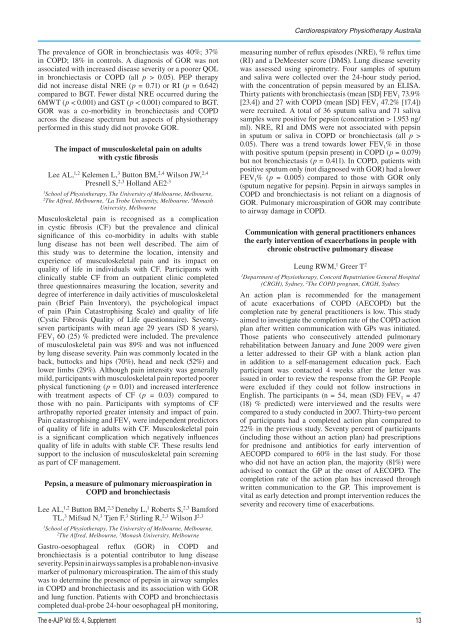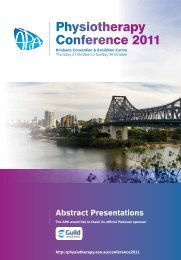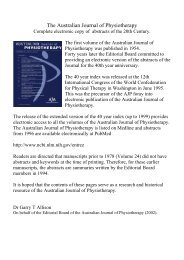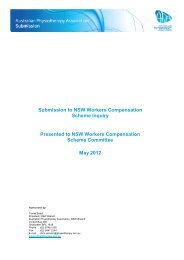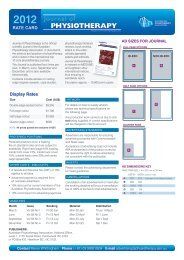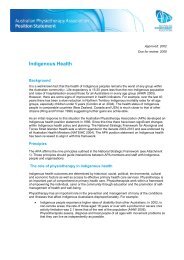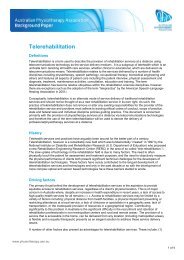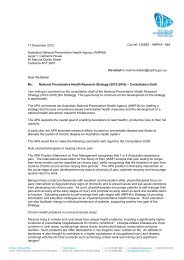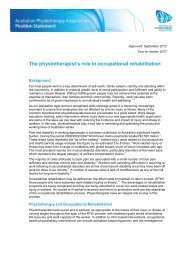2009 APA Conference Week Abstracts - Australian Physiotherapy ...
2009 APA Conference Week Abstracts - Australian Physiotherapy ...
2009 APA Conference Week Abstracts - Australian Physiotherapy ...
Create successful ePaper yourself
Turn your PDF publications into a flip-book with our unique Google optimized e-Paper software.
Cardiorespiratory <strong>Physiotherapy</strong> Australia<br />
The prevalence of GOR in bronchiectasis was 40%; 37%<br />
in COPD; 18% in controls. A diagnosis of GOR was not<br />
associated with increased disease severity or a poorer QOL<br />
in bronchiectasis or COPD (all p > 0.05). PEP therapy<br />
did not increase distal NRE (p = 0.71) or RI (p = 0.642)<br />
compared to BGT. Fewer distal NRE occurred during the<br />
6MWT (p < 0.001) and GST (p < 0.001) compared to BGT.<br />
GOR was a co-morbidity in bronchiectasis and COPD<br />
across the disease spectrum but aspects of physiotherapy<br />
performed in this study did not provoke GOR.<br />
The impact of musculoskeletal pain on adults<br />
with cystic fibrosis<br />
Lee AL, 1,2 Kelemen L, 3 Button BM, 2,4 Wilson JW, 2,4<br />
Presnell S, 2,3 Holland AE2 ,3<br />
1<br />
School of <strong>Physiotherapy</strong>, The University of Melbourne, Melbourne,<br />
2<br />
The Alfred, Melbourne, 3 La Trobe University, Melbourne, 4 Monash<br />
University, Melbourne<br />
Musculoskeletal pain is recognised as a complication<br />
in cystic fibrosis (CF) but the prevalence and clinical<br />
significance of this co-morbidity in adults with stable<br />
lung disease has not been well described. The aim of<br />
this study was to determine the location, intensity and<br />
experience of musculoskeletal pain and its impact on<br />
quality of life in individuals with CF. Participants with<br />
clinically stable CF from an outpatient clinic completed<br />
three questionnaires measuring the location, severity and<br />
degree of interference in daily activities of musculoskeletal<br />
pain (Brief Pain Inventory), the psychological impact<br />
of pain (Pain Catastrophising Scale) and quality of life<br />
(Cystic Fibrosis Quality of Life questionnaire). Seventyseven<br />
participants with mean age 29 years (SD 8 years),<br />
FEV 1 60 (25) % predicted were included. The prevalence<br />
of musculoskeletal pain was 89% and was not influenced<br />
by lung disease severity. Pain was commonly located in the<br />
back, buttocks and hips (70%), head and neck (52%) and<br />
lower limbs (29%). Although pain intensity was generally<br />
mild, participants with musculoskeletal pain reported poorer<br />
physical functioning (p = 0.01) and increased interference<br />
with treatment aspects of CF (p = 0.03) compared to<br />
those with no pain. Participants with symptoms of CF<br />
arthropathy reported greater intensity and impact of pain.<br />
Pain catastrophising and FEV 1 were independent predictors<br />
of quality of life in adults with CF. Musculoskeletal pain<br />
is a significant complication which negatively influences<br />
quality of life in adults with stable CF. These results lend<br />
support to the inclusion of musculoskeletal pain screening<br />
as part of CF management.<br />
Pepsin, a measure of pulmonary microaspiration in<br />
COPD and bronchiectasis<br />
Lee AL, 1,2 Button BM, 2,3 Denehy L, 1 Roberts S, 2,3 Bamford<br />
TL, 3 Mifsud N, 3 Tjen F, 3 Stirling R, 2,3 Wilson J 2,3<br />
1<br />
School of <strong>Physiotherapy</strong>, The University of Melbourne, Melbourne,<br />
2<br />
The Alfred, Melbourne, 3 Monash University, Melbourne<br />
Gastro-oesophageal reflux (GOR) in COPD and<br />
bronchiectasis is a potential contributor to lung disease<br />
severity. Pepsin in airways samples is a probable non-invasive<br />
marker of pulmonary microaspiration. The aim of this study<br />
was to determine the presence of pepsin in airway samples<br />
in COPD and bronchiectasis and its association with GOR<br />
and lung function. Patients with COPD and bronchiectasis<br />
completed dual-probe 24-hour oesophageal pH monitoring,<br />
measuring number of reflux episodes (NRE), % reflux time<br />
(RI) and a DeMeester score (DMS). Lung disease severity<br />
was assessed using spirometry. Four samples of sputum<br />
and saliva were collected over the 24-hour study period,<br />
with the concentration of pepsin measured by an ELISA.<br />
Thirty patients with bronchiectasis (mean [SD] FEV 1 73.9%<br />
[23.4]) and 27 with COPD (mean [SD] FEV 1 47.2% [17.4])<br />
were recruited. A total of 36 sputum saliva and 71 saliva<br />
samples were positive for pepsin (concentration > 1.953 ng/<br />
ml). NRE, RI and DMS were not associated with pepsin<br />
in sputum or saliva in COPD or bronchiectasis (all p ><br />
0.05). There was a trend towards lower FEV 1 % in those<br />
with positive sputum (pepsin present) in COPD (p = 0.079)<br />
but not bronchiectasis (p = 0.411). In COPD, patients with<br />
positive sputum only (not diagnosed with GOR) had a lower<br />
FEV 1 % (p = 0.005) compared to those with GOR only<br />
(sputum negative for pepsin). Pepsin in airways samples in<br />
COPD and bronchiectasis is not reliant on a diagnosis of<br />
GOR. Pulmonary microaspiration of GOR may contribute<br />
to airway damage in COPD.<br />
Communication with general practitioners enhances<br />
the early intervention of exacerbations in people with<br />
chronic obstructive pulmonary disease<br />
Leung RWM, 1 Greer T 2<br />
1<br />
Department of <strong>Physiotherapy</strong>, Concord Repatriation General Hospital<br />
(CRGH), Sydney, 2 The COPD program, CRGH, Sydney<br />
An action plan is recommended for the management<br />
of acute exacerbations of COPD (AECOPD) but the<br />
completion rate by general practitioners is low. This study<br />
aimed to investigate the completion rate of the COPD action<br />
plan after written communication with GPs was initiated.<br />
Those patients who consecutively attended pulmonary<br />
rehabilitation between January and June <strong>2009</strong> were given<br />
a letter addressed to their GP with a blank action plan<br />
in addition to a self-management education pack. Each<br />
participant was contacted 4 weeks after the letter was<br />
issued in order to review the response from the GP. People<br />
were excluded if they could not follow instructions in<br />
English. The participants (n = 54, mean (SD) FEV 1 = 47<br />
(18) % predicted) were interviewed and the results were<br />
compared to a study conducted in 2007. Thirty-two percent<br />
of participants had a completed action plan compared to<br />
22% in the previous study. Seventy percent of participants<br />
(including those without an action plan) had prescriptions<br />
for prednisone and antibiotics for early intervention of<br />
AECOPD compared to 60% in the last study. For those<br />
who did not have an action plan, the majority (81%) were<br />
advised to contact the GP at the onset of AECOPD. The<br />
completion rate of the action plan has increased through<br />
written communication to the GP. This improvement is<br />
vital as early detection and prompt intervention reduces the<br />
severity and recovery time of exacerbations.<br />
The e-AJP Vol 55: 4, Supplement 13


